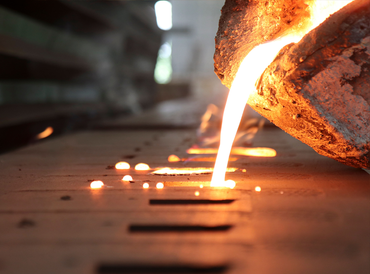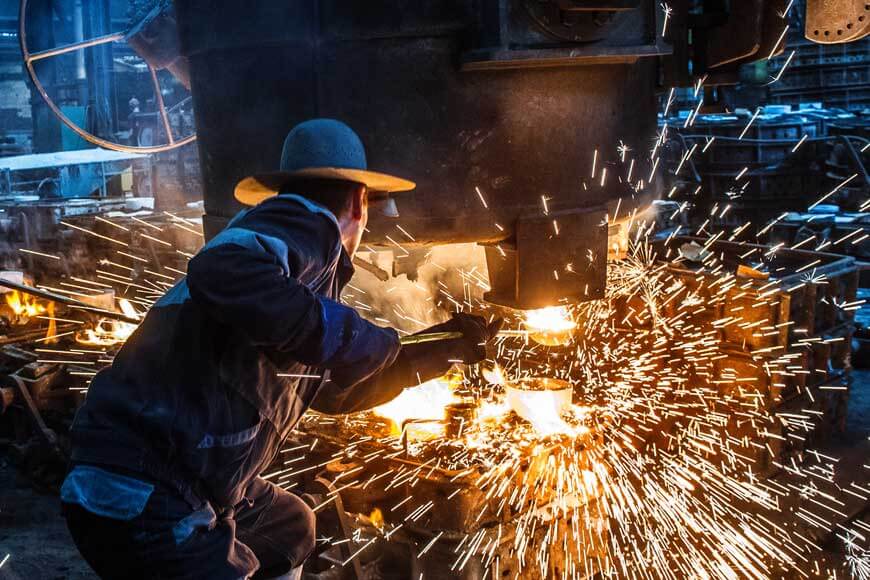Next-Gen Innovations for Metal Casting in Digital Foundries
Wiki Article
All About Metal Casting: Exactly How Foundries Provide Top Quality and Precision in Production
Metal casting stands as a foundational procedure in manufacturing, where raw metals are changed right into specific parts. Foundries use different casting techniques to attain desired features and shapes. Each method includes its own collection of restrictions and advantages. Comprehending these subtleties is important for valuing exactly how top quality and precision are kept throughout the procedure. The conversation ahead will certainly explore the complex characteristics of metal casting and its relevance throughout multiple markets.The Fundamentals of Metal Casting
Metal casting is a basic procedure in producing that involves forming liquified metal right into preferred kinds. This important technique starts with the selection of resources, often different metal alloys, which are thawed in a furnace. Once the metal reaches the appropriate temperature level, it becomes fluid and all set for casting.The process calls for a mold and mildew, normally made from sand, metal, or ceramic, which specifies the final form of the actors object. As soon as the liquified metal is put into the mold, it cools and strengthens, taking on the mold and mildew's contours.
After cooling down, the casting is eliminated from the mold, and any required finishing processes, such as polishing or trimming, are carried out. This technique allows makers to generate intricate forms and elements with high precision and very little waste. Metal casting is widely used across different markets, from automotive to aerospace, underscoring its relevance in contemporary manufacturing.
Kinds Of Casting Methods
While different casting techniques exist, each strategy provides unique benefits and is suited for different applications. Sand casting, among one of the most common techniques, uses sand as the mold material, permitting intricate layouts and big components. Investment casting, understood for its precision, uses a wax pattern coated in ceramic, making it perfect for complicated geometries. Die casting, which entails forcing molten metal right into mold and mildews under high stress, is often made use of for automation of little, in-depth parts. Additionally, covering molding integrates sand and resin to create thinner, extra exact mold and mildews, boosting surface coating. An additional technique, continual casting, enables the production of lengthy lengths of metal shapes, simplifying production processes. Each of these methods plays a pivotal function in the metal casting sector, attending to details requirements from manufacturing volume to develop complexity, thereby contributing to the variety of applications across numerous fields.The Function of Foundries in Manufacturing
Foundries serve an important feature in the manufacturing landscape, as they transform raw metals into useful parts through numerous casting procedures. These facilities utilize a variety of methods to develop items that meet specific specifications, consequently making sure high quality and effectiveness in manufacturing (Aluminum Foundry). By making use of techniques such as sand casting, investment casting, and die casting, shops satisfy varied industries, consisting of automotive, aerospace, and building and construction
Eventually, shops are indispensable to the production ecosystem, providing crucial components that support a large range of industries and applications. Their precision and versatility drive effectiveness in modern manufacturing.
Materials Used in Metal Casting
The selection of materials used in metal casting is crucial for accomplishing the desired homes and efficiency of the last product. Different steels such as iron, bronze, and aluminum are commonly employed, each offering distinct advantages. Light weight aluminum is favored for its light-weight and corrosion-resistant qualities, making it optimal for automobile and aerospace applications. Iron, particularly cast iron, is recognized for its outstanding fluidity and strength, appropriate for hefty equipment and facilities components. Bronze, with its superior wear resistance, is frequently used in marine atmospheres.Furthermore, materials such as silica sand are often utilized for mold and mildew production, offering a great equilibrium in between resilience and convenience of shaping. The selection of materials likewise includes ingredients like changes, which improve the casting process by improving fluidity and minimizing oxidation. Eventually, the appropriate option of these materials significantly affects the efficiency and quality of the casting procedure.
Quality Control in the Casting Process
Quality assurance in the casting process is important to ensure that final items satisfy industry requirements and specs. Different inspection strategies are employed to recognize defects and examine the integrity of cast elements. Additionally, adherence to developed certifications and standards enhances the dependability and performance of cast products.Examination Techniques Employed
Maintaining the honesty of cast metal parts counts greatly on different evaluation strategies. Foundries use aesthetic assessments as an initial measure to identify surface flaws, such as additions or cracks. Non-destructive screening (NDT) methods, consisting of ultrasonic testing and radiographic evaluation, are essential for finding interior defects without compromising the element's honesty. Dimensional examinations making use of calipers and coordinate measuring devices confirm that components satisfy defined tolerances. Additionally, chemical analysis verifies that the alloy make-up straightens with required criteria. These inspection strategies collectively confirm that the spreadings satisfy the required top quality and efficiency standards, inevitably reducing the risk of failure in their designated applications. Applying these strenuous inspections is essential for keeping high requirements in metal casting manufacturing.Specifications and Certifications
Specifications and qualifications play a crucial role in the quality assurance of the casting procedure. Foundries stick to various worldwide and industry-specific requirements, such as ISO 9001 and ASTM standards, assuring consistency and dependability in their products. These criteria describe the needed requirements for products, manufacturing approaches, and screening treatments, contributing to a much more effective production procedure. Certifications, you could look here such as AS9100 for aerospace applications, further stress the importance of quality control in specialized markets. By acquiring these qualifications, foundries show their dedication to excellence, lowering issues and boosting client complete satisfaction. Regular audits and evaluations confirm conformity, cultivating continuous improvement and technology within the industry. Eventually, adherence to established standards grows trust fund in between makers and clients.Developments in Casting Technology

3D Printing Assimilation
Integrating 3D printing innovation right into metal casting processes is transforming the manufacturing landscape. This ingenious combination boosts the style and production of complicated geometries that traditional approaches battle to accomplish. By employing additive manufacturing for developing cores and molds, foundries can greatly reduce lead times and product waste. In addition, 3D printing allows for fast prototyping, making it possible for suppliers to test styles promptly and successfully, thereby helping with repetitive enhancements. This modern technology additionally sustains the manufacturing of lightweight components, which are important in markets such as aerospace and auto. Therefore, the combination of 3D printing not only enhances operations however likewise elevates the precision and quality of actors metal items, marking a notable advancement in the market.Automated Production Processes
The innovations in 3D printing have actually paved the means for additional developments in automatic manufacturing processes within metal casting. Foundries are significantly embracing robotics and automation to enhance effectiveness and precision. Automated systems streamline the whole casting process, from mold creation to finishing and putting. Smart sensing units and real-time tracking enable precise control of temperatures and material circulation, reducing waste and improving quality. Furthermore, software application look at here services promote far better style and simulation, making it possible for makers to maximize procedures prior to production starts. These automatic manufacturing procedures not only decrease labor costs yet likewise minimize human error, making certain consistent result. Consequently, the assimilation of advanced modern technologies in metal casting is reinventing production capacities and meeting the growing needs of numerous markets.Advanced Material Development
As sectors require higher performance and sustainability, developments in product growth for metal casting are emerging as a crucial emphasis. Scientists and engineers are checking out brand-new alloys and composites that enhance mechanical properties while decreasing environmental influence. Technologies include light-weight products that maintain strength, enabling much better fuel efficiency in transportation applications. In addition, the unification of recycled materials is coming to be much more widespread, aligning with sustainability goals. Advanced casting methods, such as 3D printing and precision molding, enable the development of intricate geometries that standard techniques can not attain. These advancements not just enhance the capability of actors components but additionally boost manufacturing performance. Generally, the continual development of material science drives the future of metal casting, fulfilling the demands of contemporary sectors.
Applications of Metal Casting Throughout Industries
Metal casting plays an essential duty in various markets, as it enables the manufacturing of intricate shapes and top quality parts with relative performance - Metal Foundry. In the auto field, cast steels are vital for creating engine blocks, transmission cases, and various other crucial parts that require toughness and precision. Aerospace markets make use of metal casting for parts like generator blades and structural visit their website elements, where dependability is vitalIn addition, machinery and devices production gain from metal casting by generating equipments, real estates, and various other complex components that boost performance. The building and construction market additionally employs metal casting for architectural features, architectural supports, and fittings, showcasing flexibility.
Furthermore, the medical area depends on actors steels for surgical instruments and implants, highlighting the need for biocompatibility. On the whole, metal casting is a fundamental process throughout several industries, offering solutions that satisfy rigid quality requirements and performance demands.
Often Asked Questions
What Safety And Security Actions Are Absorbed Metal Casting Foundries?
In metal casting foundries, security steps include safety equipment, air flow systems, normal devices maintenance, worker training, and emergency situation protocols to alleviate threats connected with heats, dangerous materials, and prospective mishaps throughout the casting process.How Do Foundries Take Care Of Waste and Environmental Impact?
Foundries manage waste and environmental effect with reusing products, applying filtration systems for emissions, and adhering to laws - Aluminum Casting. They additionally take on sustainable practices, such as decreasing energy usage and using green substances in their processesWhat Are the Costs Connected With Metal Casting Processes?
The costs related to metal casting procedures include resources, labor, equipment maintenance, power consumption, and waste administration. In addition, variations in market prices and conformity with environmental regulations can significantly affect general expenses for factories.Just How Does Metal Casting Compare to Various Other Manufacturing Approaches?
Metal casting offers unique benefits, such as intricate forms and high material efficiency, contrasted to approaches like machining or marking. Nevertheless, it might entail much longer lead times and higher first prices, depending on project specifications.
What Occupation Opportunities Exist in the Metal Casting Industry?
The metal casting market uses numerous career opportunities, consisting of shop management, procedure design, top quality assurance, mold layout, and machine procedure. Experts can likewise pursue functions in research study and growth, sales, and environmental health and wellness and security.Metal casting stands as a fundamental procedure in manufacturing, where raw metals are changed right into specific elements. Metal casting is a basic procedure in manufacturing that entails forming molten metal right into desired kinds. Another technique, continuous casting, enables the manufacturing of long lengths of metal shapes, enhancing manufacturing processes. The expenses linked with metal casting procedures include raw materials, labor, equipment upkeep, energy consumption, and waste administration. The metal casting sector provides various profession chances, consisting of factory monitoring, procedure design, quality guarantee, mold and mildew design, and maker procedure.
Report this wiki page